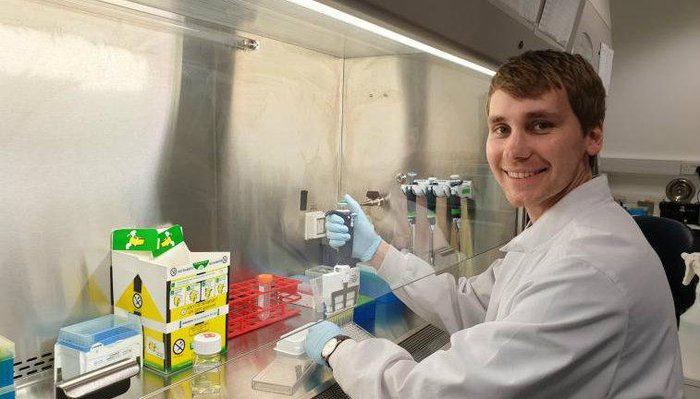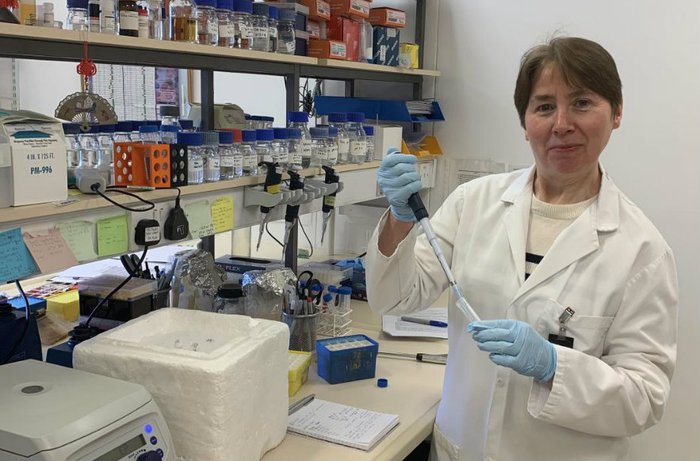Research links development of childhood leukaemia to immune system mistakes
Genetic mutations that drive the development of a common type of childhood leukaemia can be traced back to errors by the immune system during the production of antibodies.

Dr. Christopher Kirkham, joint first author on the paper
The discovery by scientists at the University of Leeds could lead to new ways to treat a number of childhood blood cancers.
The immune system needs to generate millions of different antibodies every day to fight a vast number of potential infections. To meet this demand, the white blood cells that make antibodies ‘reshuffle’ their DNA by cutting and re-joining it to produce unique antibodies.
The Leeds team have identified a new way that mistakes in this process can lead to childhood leukaemia. The research, which we primarily funded, is published in the journal Molecular Cell.
'Cut and run'
During antibody production DNA is cut and joined by enzymes called ‘recombinases’ and the unwanted regions of DNA in between the required gene segments are then ‘kicked out’ of the genome.
The researchers found that recombinase enzymes sometimes bind with these DNA by-products – creating highly dangerous enzyme/DNA complexes that cause random DNA cuts throughout the genome, leading to cancer. They have named the process ‘cut and run’.
Explaining the second leukaemia 'trigger'
It's been previously shown by researchers at the Institute of Cancer Research, London, that the most common type of childhood blood cancer, acute lymphoblastic leukaemia (ALL), starts with a genetic mutation in the womb.
This initiating genetic mutation alone cannot directly cause leukaemia – cancer will only develop if secondary genetic mutations take place during early childhood. For example, the ETV6/RUNX1 chromosomal translocation is found in around a quarter of cases of childhood ALL, but only around one in 100 children born with the ETV6/RUNX1 translocation go on to develop leukaemia.
The Leeds researchers showed that the ‘cut and run’ process can explain how some of these secondary mutations take place in ETV6/RUNX1 leukaemia.
They added the enzyme/DNA complexes to cells derived from cancer patients in the laboratory. The resulting genetic mutations that formed were located on the genome using DNA sequencing, sophisticated computer programmes and a technique called polymerase chain reaction, which can make multiple copies of specific regions of DNA.
28 of the chromosome changes caused by ‘cut and run’ were also present in children with leukaemia with the ETV6/RUNX1 mutation. Not only this, but the DNA breaks caused by ‘cut and run' occurred in the same cancer-causing genes that are frequently mutated in ETV6/RUNX1-positive leukaemia and other leukaemias.
Potential for new treatments
Dr Joan Boyes, who led the research at the University of Leeds’ School of Molecular and Cellular Biology, said: “The price we pay for such an effective immune system is that occasionally mistakes can be made that can cause blood cancers to develop. Now that we know exactly how this process works, we may be able to stop it – leading to new drugs to treat children in the future.”

Dr Joan Boyes
r Alasdair Rankin, our Director of Research and Patient Experience, said: “We know that childhood leukaemia needs at least two steps to develop and some evidence suggests that the second trigger occurs when a child’s immune system reacts in an abnormal way to infections. As important research like this helps build a more complete picture of what causes childhood leukaemia, we can begin to think about ways to stop it happening in the first place.”
The University of Leeds researchers also received funding from the Engineering and Physical Sciences Research Council, the China Scholarship Council, Yorkshire Cancer Research and the National Centre for the Replacement, Refinement and Reduction of Animals in Research (NC3Rs).
As part of their commitment to the principles of the 3Rs (the replacement, reduction and refinement of animals in research), the Leeds team used cancer cell lines in the laboratory for their research, with the goal to replace some experiments on mice.
Learn more about our groundbreaking research
